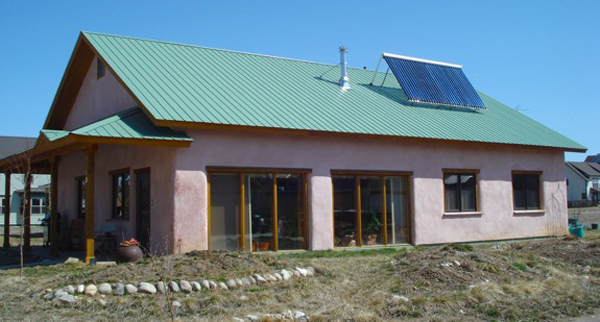
“This passive solar straw bale house is situated in one of the coldest places in the nation.
Gunnison, Colorado, ranks within the top 5 cities with the average coldest temperatures in the United States, yet the insulating properties of the straw bales make this an efficient and comfortable passive solar home. An amazing aspect of this house is that it is made primarily from all natural materials: straw, wood and various mixtures of adobe mud, including mud-plaster, cob (free form clay with straw) and adobe bricks.
While Gunnison typically has frigid below-zero temperatures in the winter, it also has over 300+ sunny days out of the year, making a passive solar design ideal.
This passive solar straw bale home radiates a quiet warmth, while its thick walls give a sense of strength and security. The absence of the fans and motors associated with forced air heating create a quiet atmosphere as the floors radiate heat. Even on a cloudy day, the straw bale home was comfortable and warm.”
More at the source: Green Passive Solar.com

I would like a contractor near Abilene to get a price to build a cob or straw home.
Ask around your area. Maybe put an ad in a local newspaper.
Owen makes an excellent suggestion about workshops.
However, don’t misunderstand Owen’s suggestion. Workshops are great, but there will still be a very large amount of work that will need to be done to build a house above and beyond the work that gets accomplished during most workshops.
It will be wise to find people that you can trust that will assist you in your efforts, before any workshops, during workshops, and after.
My suggestion…
Think small. Build small. Don’t build more house than you need. Keep it simple.
In response to Darron Fletcher,
I am looking to build an earth friendly home and I am looking into either an Earthbag or Straw bale home however I am having a hard time finding anyone in my area of Oklahoma that builds them and if they do they want more for them than a traditional home.
I would build it myself however I am disabled and am unable to do the lifting required to make this myself.
I would love to have a home where even if I’m not living off the grid I can reduce my carbon footprint however as I stated above I am unable to afford the builders and am unable to do the work myself.
One option: have a workshop. Build a tiny house that can be finished quickly. Maybe use gravel bag foundation and straw bales. You’ll want to be in a rural area so you don’t have to hassle with the code nazis. Start a blog and use it as a platform to promote your project.
I think thin stick-framed homes continue to be built in the US because people have lost their self-confidence and don’t believe they can complete a big project. Our government rewards under achievement with the dull system. Credit is designed to make it easier to hire someone else to do the work than for you to work yourself, after all it only costs x amount a month. One of the unseen shackles of credit is its ability to kill the “can do” attitude in people. After all I can get what I want for only x amount a month and I want it now. The pioneers new how to start a project and see it through. Very few people have the drive and fortitude to take the road less traveled by.
Darron
Very good points. I might add it’s far easier to tackle a do-it-yourself project if it’s simple and simple. Start off with a tool shed or something small to develop your skills.
It makes to much sense!
Surprisingly most people continue to build thin stick-framed walls in climates like this.